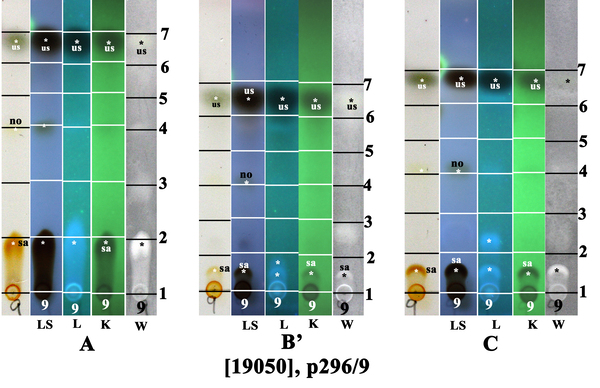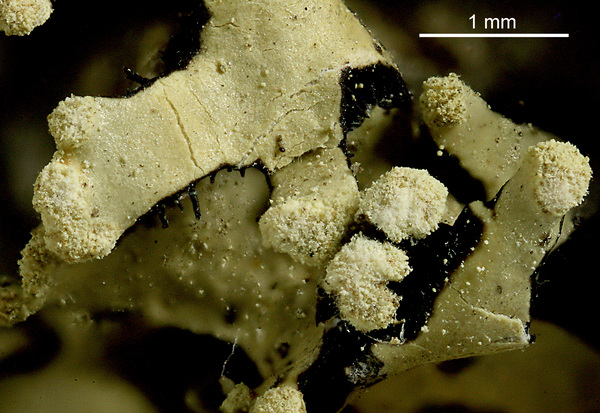Hypotrachyna sinuosa (Sm.) Hale
Smithsonian Contr. Bot., 25: 63, 1975. Basionym: Lichen sinuosus Sm. in Smith & Sowerby - Engl. Bot., 29: 2050, 1809.
Synonyms: Imbricaria sinuosa (Sm.) Körb.; Parmelia despreauxii Delise; Parmelia sinuosa (Sm.) Ach.; Parmelia sinuosa var. virescens Kremp.
Distribution: N - Frl, Ven (Watson 2014), TAA (Nascimbene & al. 2007b, 2022, Nimis & al. 2015), Lomb (Zocchi & al. 1997), Piem (Isocrono & al. 2004, Ravera & al. 2024b), Emil (Fariselli & al. 2020). C - Tosc, Umb (Ravera & al. 2006), Sar. S - Cal (S- L65878).
Description: Thallus foliose, heteromerous, dorsiventral, rather loosely attached, forming more or less irregular, 1-3(-7) cm wide patches, sorediate. Lobes 0.5-2(-3) mm wide, separate to contiguous or overlapping in central parts, dichotomously branched with markedly sinuate, rounded axils, and wider, often ascending, truncate tips. Upper surface yellowish green, emaculate, smooth, more or less shiny, with farinose, greenish to rarely brownish soredia arranged in subcapitate soralia at the apex of ascending lobes. Lower surface black, shiny, with dense, dichotomously branched, black to dark brown, shiny rhizines which often project beyond the margins and are visible from above as a dense mat. Upper cortex of tightly packed, anticlinally oriented hyphae, with a pored epicortex, the cell walls with isolichenan; medulla white; lower cortex brown, of anticlinally oriented hyphae. Apothecia extremely rare, lecanorine, with a brown disc and an often sorediate thalline margin. Asci 8-spored, clavate, Lecanora-type. Ascospores 1-celled, hyaline, ellipsoid, 10-14 x 7-9 µm. Pycnidia rare, black, laminal, immersed. Conidia bacilliform, wider at one end, 4-5 µm long. Photobiont chlorococcoid. Spot tests: upper cortex K-, C-, KC+ faintly yellow, P-; medulla K+ yellow turning red, C-, KC+ red, P+ orange, UV-. Chemistry: upper cortex with usnic acid; medulla with salazinic acid (major) and traces of consalazinic and norstictic acids.
Note: a widespread, but rare mild-temperate species found on bark and epiphytic mosses in open, humid and cold forests; declining throughout the country and presently almost extinct. All records from Southern Italy reported by Nimis (1993: 483) and that from Umbria (Panfili 2000), being dubious, are not accepted here. It is included in the Italian red list of epiphytic lichens as “Vulnerable” (Nascimbene & al. 2013c).
Growth form: Foliose, broad lobed
Substrata: bark
Photobiont: green algae other than Trentepohlia
Reproductive strategy: mainly sexual
Most common in areas with a humid-warm climate (e.g. most of Tyrrenian Italy)
Commonnes-rarity: (info)
Alpine belt: absent
Subalpine belt: absent
Oromediterranean belt: absent
Montane belt: very rare
Submediterranean belt: extremely rare
Padanian area: absent
Humid submediterranean belt: extremely rare
Humid mediterranean belt: absent
Dry mediterranean belt: absent
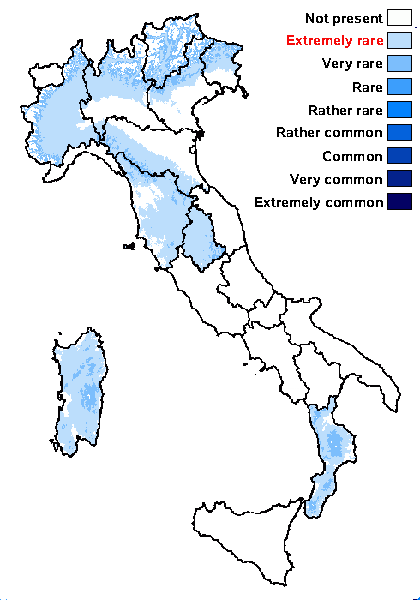
Predictive model
Herbarium samples


Felix Schumm CC BY-SA 4.0
[19050], New Zealand, North Island, Wellington, Tongariro National Park, Lake Ropounamu walking track, 39°01' S, 175° 44' E, 700 m, forest, on small branches and twigs
Leg. J. Johnston (2305), 19.03.1985.
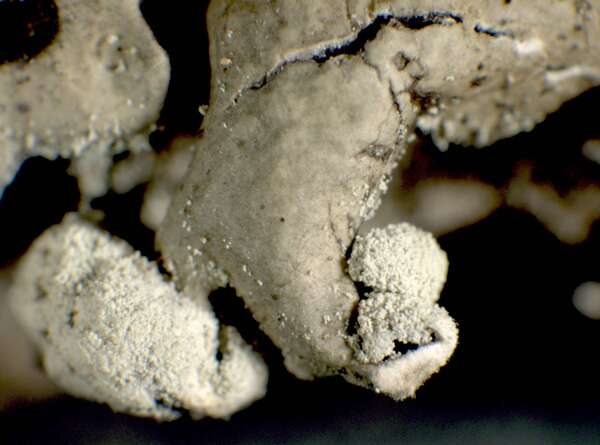

P.L. Nimis; Owner: Department of Life Sciences, University of Trieste
Herbarium: TSB (1744)
2001/12/05
detail of soralia
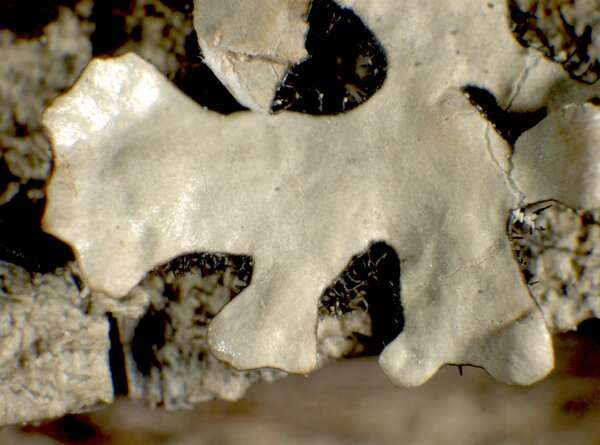

P.L. Nimis; Owner: Department of Life Sciences, University of Trieste
Herbarium: TSB (1744)
2001/12/05
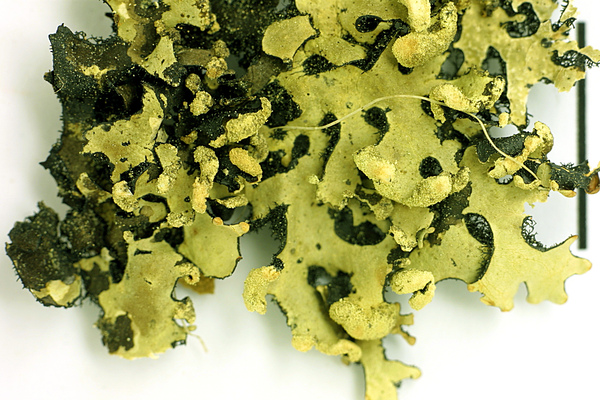

Felix Schumm - CC BY-SA 4.0
[3081], Schottland, River Elchaig, zwischen Comas Luinie und den Falls of Glomach, ca. 50 m NN; an Laubbäumen zusammen mit Lobaria scrobiculata, Pannaria rubiginosa, Normandina pulchella. Leg. Schumm 14.08.1985, det. Schumm 1985.
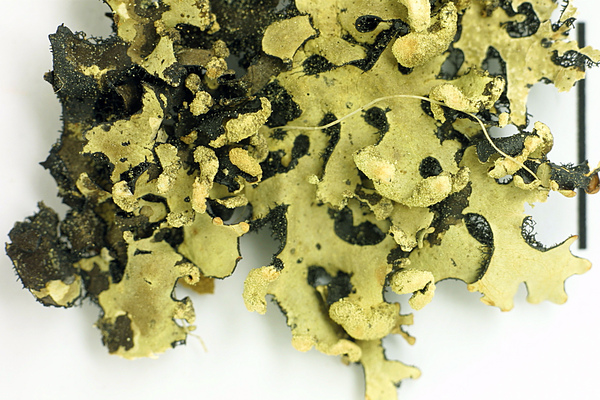

Felix Schumm - CC BY-SA 4.0
[3081], Schottland, River Elchaig, zwischen Comas Luinie und den Falls of Glomach, ca. 50 m NN; an Laubbäumen zusammen mit Lobaria scrobiculata, Pannaria rubiginosa, Normandina pulchella. Leg. Schumm 14.08.1985, det. Schumm 1985.
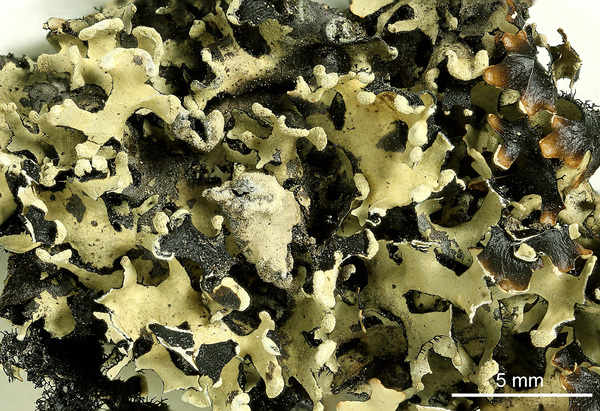

Felix Schumm - CC BY-SA 4.0
[19050], New Zealand, North Island, Wellington, Tongariro National Park, Lake Ropounamu walking track, 39°01' S, 175° 44' E, 700 m, forest, on small branches and twigs. Leg. J. Johnston (2305), 19.03.1985.


Felix Schumm - CC BY-SA 4.0
[19050], New Zealand, North Island, Wellington, Tongariro National Park, Lake Ropounamu walking track, 39°01' S, 175° 44' E, 700 m, forest, on small branches and twigs. Leg. J. Johnston (2305), 19.03.1985.
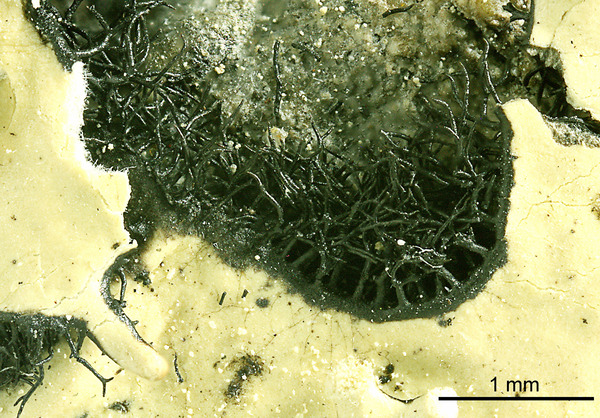

Felix Schumm - CC BY-SA 4.0
[19050], New Zealand, North Island, Wellington, Tongariro National Park, Lake Ropounamu walking track, 39°01' S, 175° 44' E, 700 m, forest, on small branches and twigs. Leg. J. Johnston (2305), 19.03.1985.
Growth form: Foliose, broad lobed
Substrata: bark
Photobiont: green algae other than Trentepohlia
Reproductive strategy: mainly sexual
Most common in areas with a humid-warm climate (e.g. most of Tyrrenian Italy)
Commonnes-rarity: (info)
Alpine belt: absent
Subalpine belt: absent
Oromediterranean belt: absent
Montane belt: very rare
Submediterranean belt: extremely rare
Padanian area: absent
Humid submediterranean belt: extremely rare
Humid mediterranean belt: absent
Dry mediterranean belt: absent

Predictive model
| Herbarium samples |


Felix Schumm CC BY-SA 4.0
[19050], New Zealand, North Island, Wellington, Tongariro National Park, Lake Ropounamu walking track, 39°01' S, 175° 44' E, 700 m, forest, on small branches and twigs
Leg. J. Johnston (2305), 19.03.1985.


P.L. Nimis; Owner: Department of Life Sciences, University of Trieste
Herbarium: TSB (1744)
2001/12/05
detail of soralia


P.L. Nimis; Owner: Department of Life Sciences, University of Trieste
Herbarium: TSB (1744)
2001/12/05


Felix Schumm - CC BY-SA 4.0
[3081], Schottland, River Elchaig, zwischen Comas Luinie und den Falls of Glomach, ca. 50 m NN; an Laubbäumen zusammen mit Lobaria scrobiculata, Pannaria rubiginosa, Normandina pulchella. Leg. Schumm 14.08.1985, det. Schumm 1985.


Felix Schumm - CC BY-SA 4.0
[3081], Schottland, River Elchaig, zwischen Comas Luinie und den Falls of Glomach, ca. 50 m NN; an Laubbäumen zusammen mit Lobaria scrobiculata, Pannaria rubiginosa, Normandina pulchella. Leg. Schumm 14.08.1985, det. Schumm 1985.


Felix Schumm - CC BY-SA 4.0
[19050], New Zealand, North Island, Wellington, Tongariro National Park, Lake Ropounamu walking track, 39°01' S, 175° 44' E, 700 m, forest, on small branches and twigs. Leg. J. Johnston (2305), 19.03.1985.


Felix Schumm - CC BY-SA 4.0
[19050], New Zealand, North Island, Wellington, Tongariro National Park, Lake Ropounamu walking track, 39°01' S, 175° 44' E, 700 m, forest, on small branches and twigs. Leg. J. Johnston (2305), 19.03.1985.


 INDEX FUNGORUM
INDEX FUNGORUM
 GBIF
GBIF
 DOLICHENS
DOLICHENS
